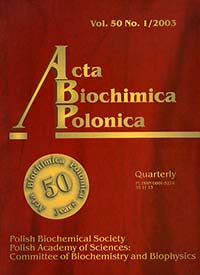Rabbit muscle fructose-1,6-bisphosphatase is phosphorylatedin vivo.
Abstract
Phosphorylated fructose-1,6-bisphosphatase (FBPase) was isolated from rabbit muscle in an SDS/PAGE homogeneous form. Its dephosphorylation with alkaline phosphatase revealed 2.8 moles of inorganic phosphate per mole of FBPase. The phosphorylated FBPase (P-FBPase) differs from the dephosphorylated enzyme in terms of its kinetic properties like K(m) and k(cat), which are two times higher for the phosphorylated FBPase, and in the affinity for aldolase, which is three times lower for the dephosphorylated enzyme. Dephosphorylated FBPase can be a substrate for protein kinase A and the amount of phosphate incorporated per FBPase monomer can reach 2-3 molecules. Since interaction of muscle aldolase with muscle FBPase results in desensitisation of the latter toward AMP inhibition (Rakus & Dzugaj, 2000, Biochem. Biophys. Res. Commun. 275, 611-616), phosphorylation may be considered as a way of muscle FBPase activity regulation.Acta Biochimica Polonica is an OpenAccess quarterly and publishes four issues a year. All contents are distributed under the Creative Commons Attribution-ShareAlike 4.0 International (CC BY 4.0) license. Everybody may use the content following terms: Attribution — You must give appropriate credit, provide a link to the license, and indicate if changes were made. You may do so in any reasonable manner, but not in any way that suggests the licensor endorses you or your use.
Copyright for all published papers © stays with the authors.
Copyright for the journal: © Polish Biochemical Society.


